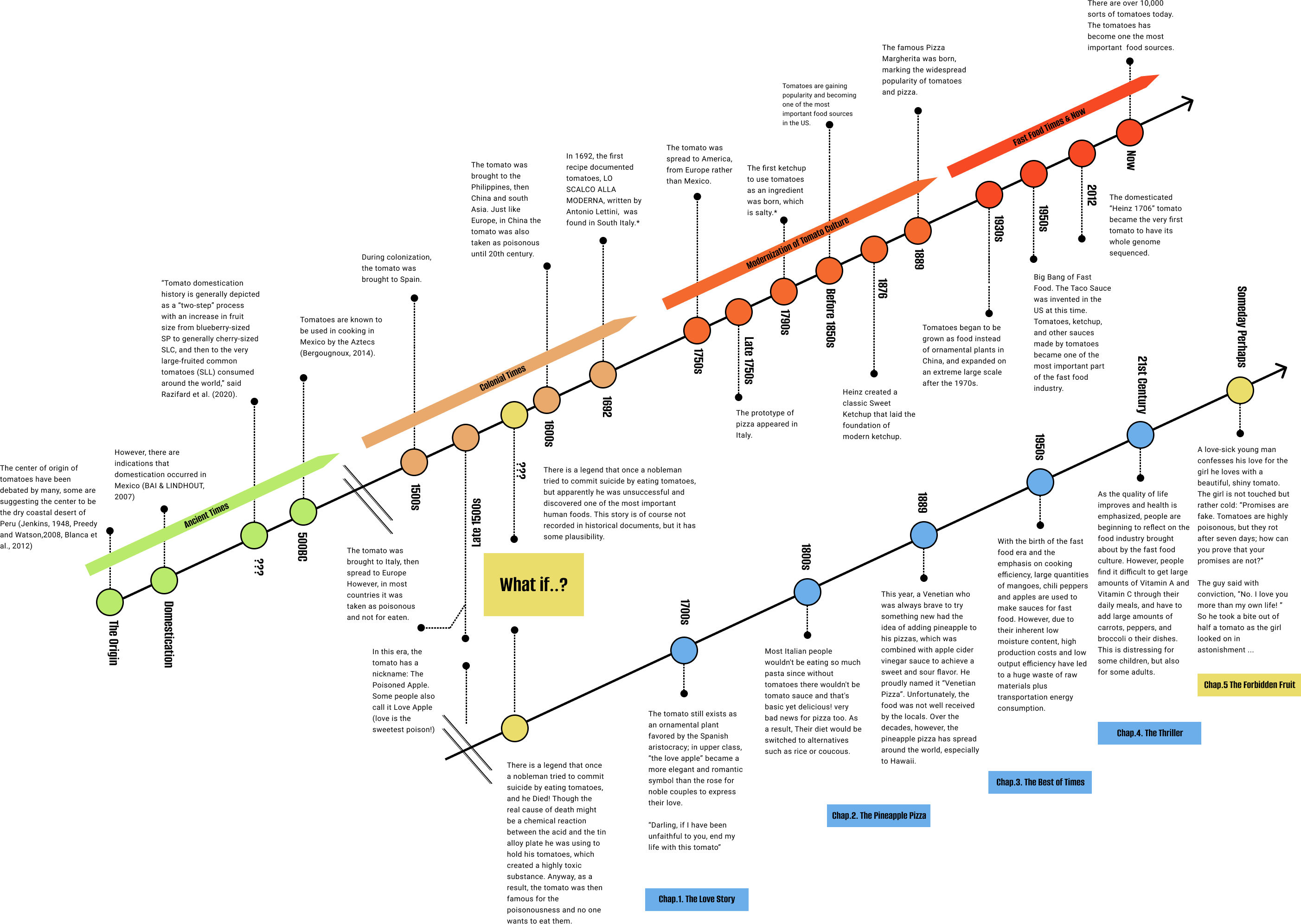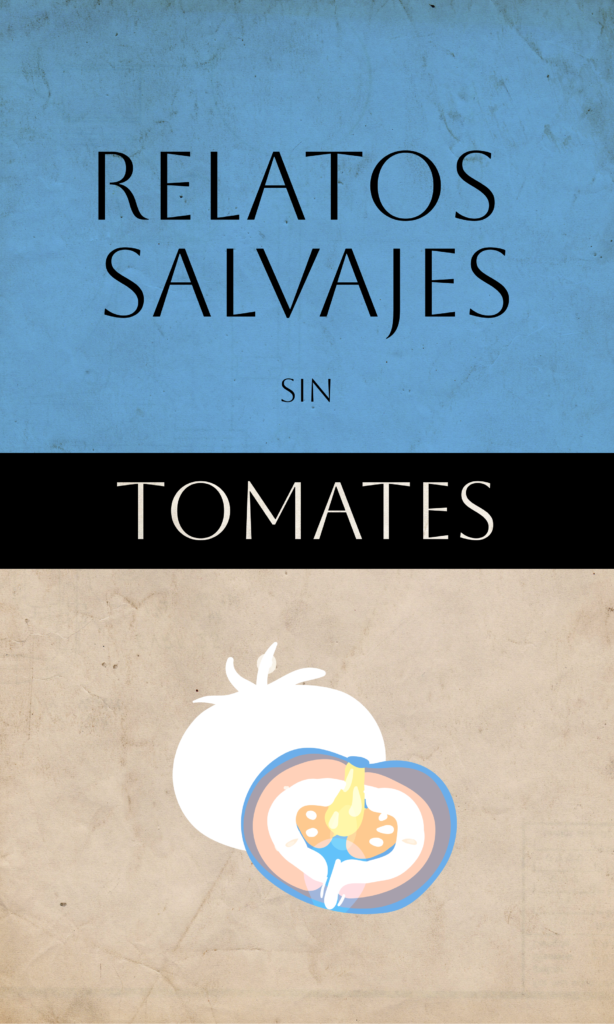Design Fiction: If NO Tomatoes for Human
Definitely, this is a super macroscopic and challenging topic. In a sense, the history of how people find, spread, and develop tomatoes is equivalent to the recent and modern history of mankind. Since the discovery of the New World, the tomato has been closely linked to the history of colonization, human food culture, the modern food industry, and capitalism. I don’t think I can complete such an ambitious topic 100 percent perfect in two weeks, which is far beyond my capability. I just want to offer some inspirations that might be helpful for your thoughts.
This fiction will focus on:
- How have tomatoes influenced people’s food culture and lifestyle? (Timeline, Chap.1,2,4)
- If humans lose their tomatoes, will it result in more food waste or less? (Chap.3.4)
- When we are talking about food waste and healthy lifestyles, are we truly realized some people in the world are still suffering from starvation today? (Chap.3.4)
—— Special thanks to My Friend Mattia from Italy, but just do not let him know the pineapple pizza part——
Timeline Map & Fork
According to the references I searched, I have divided the history of human use of tomatoes into four periods: Ancient Times, Colonial Times, Modernization of Tomato Culture, and Fast Food Times. I have divided the history of human utilization of tomatoes into four periods. There is no clear demarcation of landmark events between them; they are simply summarized based on general impressions from different sorts of data.
The timeline fork is set at a legend. It was said that one man failed the suicide with tomato and found the delicious food. What if he really died, then no one would dare to eat tomatoes? What changes would take place?
The What If timeline is also the synopsis of the whole fiction.

Here are some important or interesting points in which you may have interest:
Why were tomatoes seen as poisonous for so long (at least two centuries) ?
- There is actually no clear and scientific conclusion. One hypothesis is that the tomato is similar in shape to a local poisonous lycophyte (a generic term for plants such as eggplant and tomato). This hypothesis is reasonable, since most non-artificially cultivated lycopersicon plants are in fact poisonous, and only a few species are available for human consumption. Another assumption is that a chemical reaction between the acid in the tomato and the tin-alloy cutlery that was more commonly used five hundred years ago produced a toxic substance that could be fatal. In history, more than one death was recorded from tomato consumption, but we have no way of confirming their truthfulness.
- It took the Spanish almost one hundred years to accept the tomato, followed by the Italians. As for the rest of Europe, tomatoes were consumed one to two centuries later. The earlier adoption of the tomato by Italians was due to the fact that parts of southern Italy were occupied by Spain at the time, which indirectly contributed to the spread of the tomato.
- The earliest ketchup originated in Southeast Asia as a savory seasoning made from seafood. The sweetketchup we’re familiar with didn’t appear until around 1850. Long ago, however, Italy had numerous types of tomato sauces. Italy is known for its rich culinary traditions and diverse regional specialties, and each tomato sauce has its own unique flavor and purpose, like Marinara, Napoletana, Bolognese, Puttanesca, Arrabbiata, etc. These are just a few of the many tomato sauces available in Italy. In fact, each region and even each family may have its own unique tomato sauce recipe, adapted to individual tastes and traditions.
- Please do not use the word “ketchup” to describe the tomato sauces when talking to the Italian people, or they may feel it is kind of an insult. For them, the ketchup is just something for fries or as a side for some dishes.
- In my opinion, the answer would be that without tomatoes, food waste may increase. Tomato is a widely used ingredient that plays an important role in many dishes. Without tomatoes, people may substitute other ingredients, which may lead to more food waste.
- In addition, tomatoes are also used in the preparation of a variety of processed foods, such as ketchup, which have a longer shelf life and reduce food waste. Therefore, the absence of tomatoes may complicate food preservation and substitution options, which may increase food waste.
- Not only food waste, the absence of tomatoes may also generate more transportation costs and waste; remember, tomatoes can be planted almost everywhere in the world, even in high-latitude regions like Sweden. We may have to spend a lot more if people’s requirements cannot be realized locally.
- Last but not least, among many countries and nations, tomatoes are one of the most important food resources that everyone can afford, and it is difficult to find any substitute. Not only tomatoes, the loss of such basic food resources may lead to severe social inequality. In Chapter 3 of the fiction, I am trying to discourse such potential possibilities with a tune of black humor.
Fiction Prototype (Generated by Sudowrite & Midjourney with manual calibrations)
https://editor.sudowrite.com/
https://www.midjourney.com/
Relatos salvajes sin tomates
(Wild Tales without Tomatoes)

Inspired by the Argentinean movie of the same name, Relatos Salvajes. It is Spanish, meaning “the wild stories“. Similar to the narrative structure of the movie, the short story consists of five unrelated stories that share the same theme: how would the world change if tomatoes were not used as a food, but instead were long regarded as a deadly poison?

Content Introduction
Chapter 1 The Love Story: takes place in the 18th century. It envisions tomatoes as a romantic token of love.
Chapter 2 The Pineapple Pizza: takes place in the late 19th century. It explores how people’s eating habits and cultural traditions would have changed without the tomato as an important ingredient.
Chapter 3 The Best of Times: takes place in a fantasy era of both fast food and economic crisis. A scenario is envisioned in which the disappearance of tomatoes leads to massive food waste. With the loss of tomatoes, the cost of making sauces similar to ketchup would increase dramatically, indirectly leading to a large amount of wasted raw materials; at the same time, due to lower output efficiency, factories would have to increase their profits by squeezing laborers and increasing the price of their products, thus exacerbating social inequality.
Chapter 4 The Thriller: takes place in a time when people began to emphasize nutritional balance (around the 1970s and 1980s, perhaps there will still be Michael Jackson in this parallel world). Explores the lengths people will go to in their dietary practices to get the nutritional value equivalent to a tomato.
Chapter 5 The Forbidden Fruit: pays homage to the historical tradition of people who went from thinking tomatoes were poisonous to using them extensively. Thanks to the man who was the first to risk his life to try it.
Review & Criticism about Gen AI Tools
Most of the texts are generated by Sudo Writing, while the illustrations are generated by Midjourney. I am the director who controls all the beats; for the most crucial parts related to the core topic, I revised and completed them myself.
Sudo Writing is a powerful Gen AI specialized in writing, which I think is much better than ChatGPT 4. Sudo writing can amazingly realize my imagining world. I also made some illustrations by Midjourney; however, in most situations they are far from what I think they should be, though they are good and make sense.
There is no end to the imagination that words can give to humans, which is why I think literary AI will outperform image AI. Provided, of course, that you need to be an imaginative person yourself.
Also, after discussion with our presentation group members, I found I am not the only one who think the Gen AI tool may just tend to be too “positive”. For example, in Chapter 3, I want to create a tragedy, but the generated AI provides the plot like “a poor man almost starves to death, but he has hope, and he makes much effort and finally becomes rich.” I changed the prompt many times, ending up with “the man starves to death finally.” I know AI tools much obey some social responsibilities, however, humans are creatures with multiple emotions, and life is more than happy endings. It is the countless tragedies and sorrows that make up the most moving history of humankind. If AI can only provide positive values, it may not be a tool capable of mimicking human emotions.
References
Cooper, M. L. (1994). Motivations for alcohol use among adolescents: Development and validation of a four-factor model. Psychological Assessment, 6(2), 117–128.
Post-booze blackout, how people fill in the blanks. https://www.nbcnews.com/healthmain/post-booze-blackout-how-people-fill-blanks-1c6437126
—